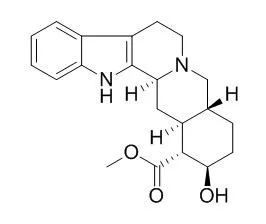METHODS AND RESULTS:
A new indole alkaloid, 12-hydroxy-N-acetyl-21(N)-dehydroplumeran-18-oic acid (13), and 11 known indole alkaloids: 3,4,5,6-tetradehydro-β-yohimbine (3), 19(E)-hunteracine (4), beta-Yohimbine(5), yohimbine (6), 19,20-dehydro-17-α-yohimbine (7), uleine (10), 20-epi-dasycarpidone (11), olivacine (8), 20-epi-N-nor-dasycarpidone (14), N-demethyluleine (15) and 20(E)-nor-subincanadine E (12) and a boonein δ-lactone 9, ursolic acid (1) and 1D,1O-methyl-chiro-inositol (2) were isolated from the EtOH extracts of different parts of Aspidosperma ulei Markgr. (Apocynaceae). Identification and structural elucidation were based on IR, MS, ¹H- and ¹³C-NMR spectral data and comparison to literature data. The antiplasmodial and antimalarial activity of 1, 5, 6, 8, 10 and 15 has been previously evaluated and 1 and 10 have important in vitro and in vivo antimalarial properties according to patent and/or scientific literature. With the aim of discovering new antiplasmodial indole alkaloids, 3, 4, 11, 12 and 13 were evaluated for in vitro inhibition against the multi-drug resistant K1 strain of the human malaria parasite Plasmodium falciparum. IC₅₀ values of 14.0 (39.9), 4.5 (16.7) and 14.5 (54.3) mg/mL (mM) were determined for 3, 11 and 12, respectively. Inhibitory activity of 3, 4, 11, 12 and 13 was evaluated against NIH3T3 murine fibroblasts.
CONCLUSIONS:
None of these compounds exhibited toxicity to fibroblasts (IC₅₀ > 50 mg/mL). Of the five compounds screened for in vitro antiplasmodial activity, only 11 was active. |






 Cell. 2018 Jan 11;172(1-2):249-261.e12. doi: 10.1016/j.cell.2017.12.019.IF=36.216(2019)
Cell. 2018 Jan 11;172(1-2):249-261.e12. doi: 10.1016/j.cell.2017.12.019.IF=36.216(2019) Cell Metab. 2020 Mar 3;31(3):534-548.e5. doi: 10.1016/j.cmet.2020.01.002.IF=22.415(2019)
Cell Metab. 2020 Mar 3;31(3):534-548.e5. doi: 10.1016/j.cmet.2020.01.002.IF=22.415(2019) Mol Cell. 2017 Nov 16;68(4):673-685.e6. doi: 10.1016/j.molcel.2017.10.022.IF=14.548(2019)
Mol Cell. 2017 Nov 16;68(4):673-685.e6. doi: 10.1016/j.molcel.2017.10.022.IF=14.548(2019)